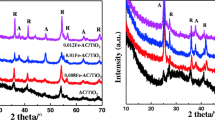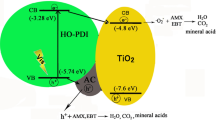Abstract
In this research, carbon nanodots decorated TiO2 (CDs/TiO2) were prepared by the microwave method and used as the catalyst for the photo-oxidation of several volatile organic compounds (VOCs), including formaldehyde, acetone, and toluene, in a continuous flow under UV-A radiation. The catalyst was characterized by X-ray diffraction (XRD), Fourier-transform infrared spectroscopy (FTIR), high-resolution transmission electron microscopy (HRTEM), scanning electronic microscopy with energy-dispersive X-ray spectroscopy (SEM-EDX), thermogravimetric analysis (TGA), and photoluminescence spectroscopy (PL). The results confirm the vital role of carbon nanodots in the improvement of photocatalytic activity of TiO2 via extending the light absorption into the visible range and lengthening the existence of photoelectrons and holes. The synthetic catalyst exhibited superior photocatalytic performance than the pristine TiO2. The removal rate of formaldehyde, acetone, and toluene in a continuous flow and under humid conditions are 0.38, 0.22, and 0.2 mmol g− 1 h− 1, respectively. While the change in relative humidity had significant impacts on the photocatalytic activity of TiO2, CDs/TiO2 still exhibited a very high and stable VOCs conversion efficiency. Moreover, the photo-oxidation efficiency of formaldehyde on the CDs/TiO2 photocatalyst was maintained the same after 8 cycles.
Highlights
Carbon nanodots were successfully prepared by a simple microwave-assisted method.
Carbon nanodots played a vital role in the improvement of the photocatalytic activity of TiO2.
Photocatalytic removal of formaldehyde, acetone, and toluene was tested under humid conditions.
High catalytic stability in the degradation of formaldehyde was obtained on CDs/TiO2.









Similar content being viewed by others
References
Acheampong M, Ejiofor C, Salinas-Miranda A, Jaward FM, Eduful M, Yu Q (2018) Bridging the under-five mortality gap for Africa in the era of sustainable development goals: an ordinary least squares (OLS) analysis. Ann Glob Health 84:225–238. https://doi.org/10.29024/aogh.9
Tsai WT (2019) An overview of health hazards of volatile organic compounds regulated as indoor air pollutants. Rev Environ Health 34:81–89. https://doi.org/10.1515/reveh-2018-0046
Lin L, Chai Y, Zhao B, Wei W, He D, He B, Tang Q (2013) Photocatalytic oxidation for degradation of VOCs. Open J Inorg Chem 3:14–25. https://doi.org/10.4236/ojic.2013.31003
Onkani SP, Diagboya PN, Mtunzi FM, Klink MJ, Olu-Owolabi BI, Pakade V (2020) Comparative study of the photocatalytic degradation of 2–chlorophenol under UV irradiation using pristine and Ag-doped species of TiO2, ZnO and ZnS photocatalysts. J Environ Manage 260:110145. https://doi.org/10.1016/j.jenvman.2020.110145
Lavanya T, Dutta M, Ramaprabhu S, Satheesh K (2017) Superior photocatalytic performance of graphene wrapped anatase/rutile mixed phase TiO2 nanofibers synthesized by a simple and facile route. J Environ Chem Eng 5:494–503. https://doi.org/10.1016/j.jece.2016.12.025
Yuan R, Zhu Y, Zhou B, Hu J (2019) Photocatalytic oxidation of sulfamethoxazole in the presence of TiO2: Effect of matrix in aqueous solution on decomposition mechanisms. J Chem Eng 359:1527–1536. https://doi.org/10.1016/j.cej.2018.11.019
Tshangana CS, Muleja AA, Mamba BB (2022) Photocatalytic activity of graphene oxide quantum dots in an effluent from a South African wastewater treatment plant. J Nanopart Res 24:43. https://doi.org/10.1007/s11051-022-05422-6
Yen TH, Van Thuan D, Hanh NT et al (2020) Synthesis of N and S co-doped TiO2 nanotubes for advanced photocatalytic degradation of volatile organic compounds (VOCs) in gas phase. Top Catal 63:1077–1085. https://doi.org/10.1007/s11244-020-01347-3
Haider AJ, Jameel ZN, Al-Hussaini IH (2019) Review on: titanium dioxide applications. Energy Procedia 157:17–29. https://doi.org/10.1016/j.egypro.2018.11.159
Li J, Zhang M, Chen J, Jia H (2020) The Effect of Noble-Metal Deposition routes on the characteristics and photocatalytic activity of M-TiBi 1.9% O 2 (M = pt and pd). Top Catal 63:882–894. https://doi.org/10.1007/s11244-020-01307-x
Li LC, Tseng YH, Lin HY (2020) Efficient photodecomposition of NO x on carbon modified Ag/TiO2 nanocomposites. Top Catal 63:1251–1260. https://doi.org/10.1007/s11244-020-01255-6
Dong H, Zeng G, Tang L, Fan C, Zhang C, He X, He Y (2015) An overview on limitations of TiO2-based particles for photocatalytic degradation of organic pollutants and the corresponding countermeasures. Water Res 79:128–146. https://doi.org/10.1016/j.watres.2015.04.038
Moma J, Baloyi J (2018) Modified Titanium Dioxide for Photocatalytic Applications. In Photocatalysts-Applications and Attributes. IntechOpen
Nasr M, Eid C, Habchi R, Miele P, Bechelany M (2018) Recent progress on titanium dioxide nanomaterials for photocatalytic applications. Chemsuschem 11:3023–3047. https://doi.org/10.1002/cssc.201800874
Chen Y, Dong X, Cao Y, Xiang J, Gao H (2017) Enhanced photocatalytic activities of low-bandgap TiO2-reduced graphene oxide nanocomposites. J Nanoparticle Res 19:1–13. https://doi.org/10.1007/s11051-017-3871-1
Kotzias D, Binas V, Kiriakidis G (2020) Smart surfaces: heterogeneous photo-catalysis on TiO2 based Coatings for De-pollution purposes in indoor and outdoor environments. Top Catal 63:875–881. https://doi.org/10.1007/s11244-020-01351-7
Razali MH, Yusoff M (2018) Highly efficient CuO loaded TiO2 nanotube photocatalyst for CO2 photoconversion. Mater Lett 221:168–171. https://doi.org/10.1016/j.matlet.2018.03.100
Pillai VV, Lonkar SP, Alhassan SM (2020) Template-free, solid-state synthesis of hierarchically macroporous S-doped TiO2 nano-photocatalysts for efficient water remediation. ACS Omega 5:7969–7978. https://doi.org/10.1021/acsomega.9b04409
Jin X, Zhou X, Sun P, Lin S, Cao W, Li Z, Liu W (2019) Photocatalytic degradation of norfloxacin using N-doped TiO2: optimization, mechanism, identification of intermediates and toxicity evaluation. Chemosphere 237:124433. https://doi.org/10.1016/j.chemosphere.2019.124433
Khalid NR, Majid A, Tahir MB, Niaz NA, Khalid S (2017) Carbonaceous-TiO2 nanomaterials for photocatalytic degradation of pollutants: a review. Ceram Int 43:14552–14571. https://doi.org/10.1016/j.ceramint.2017.08.143
Chang Q, Li KK, Hu SL, Dong YG, Yang JL (2016) Hydroxyapatite supported N-doped carbon quantum dots for visible-light photocatalysis. Mater Lett 175:44–47. https://doi.org/10.1016/j.matlet.2016.03.140
Han M, Zhu S, Lu S, Song Y, Feng T, Tao S et al (2018) Recent progress on the photocatalysis of carbon dots: classification, mechanism and applications. Nano Today 19:201–218. https://doi.org/10.1016/j.nantod.2018.02.008
Omer KM, Mohammad NN, Baban SO, Hassan AQ (2018) Carbon nanodots as efficient photosensitizers to enhance visible-light driven photocatalytic activity. J Photochem Photobiol A 364:53–58. https://doi.org/10.1016/j.jphotochem.2018.05.041
Naffati N, Sampaio MJ, Da Silva ES, Nsib MF, Arfaoui Y, Houas A et al (2020) Carbon-nanotube/TiO2 materials synthesized by a one-pot oxidation/hydrothermal route for the photocatalytic production of hydrogen from biomass derivatives. Mater Sci Semicond Process 115:105098. https://doi.org/10.1016/j.mssp.2020.105098
Liang C, Hu X, Wang Y, Zhang Y, Fu G, Li C (2021) Study on luminescence mechanism of nitrogen-doped carbon quantum dots with different fluorescence properties and application in Fe3+ detection. J Nanoparticle Res 23:101. https://doi.org/10.1007/s11051-021-05208-2
Wei J, Shen J, Zhang X, Guo S, Pan J, Hou X et al (2013) Simple one-step synthesis of water-soluble fluorescent carbon dots derived from paper ash. RSC adv 3:13119–13122. https://doi.org/10.1039/C3RA41751D
Abidin NHZ, Wongso V, Hui KC, Cho K, Sambudi NS, Ang WL, Saad B (2020) The effect of functionalization on rice-husks derived carbon quantum dots properties and cadmium removal. J Wat Proc Eng 38:101634. https://doi.org/10.1016/j.jwpe.2020.101634
Sahu S, Behera B, Maiti TK, Mohapatra S (2012) Simple one-step synthesis of highly luminescent carbon dots from orange juice: application as excellent bio-imaging agents. ChemComm 48:8835–8837. https://doi.org/10.1039/C2CC33796G
Maiti R, Mukherjee S, Haldar S, Bhowmick D, Ray SK (2016) Novel thermal quenching characteristics of luminescent carbon nanodots via tailoring the surface chemical groups. Carbon 104:226–232. https://doi.org/10.1016/j.carbon.2016.04.004
Hsu PC, Shih ZY, Lee CH, Chang HT (2012) Synthesis and analytical applications of photoluminescent carbon nanodots. Green Chem 14:917–920. https://doi.org/10.1039/C2GC16451E
Zhang X, Wang H, Ma C, Niu N, Chen Z, Liu S et al (2018) Seeking value from biomass materials: Preparation of coffee bean shell-derived fluorescent carbon dots via molecular aggregation for antioxidation and bioimaging applications. Mater Chem Front 2:1269–1275. https://doi.org/10.1039/C8QM00030A
Tu LNQ, Nhan NVH, Van Dung N, An NT, Long NQ (2019) Enhanced photocatalytic performance and moisture tolerance of nano-sized Me/TiO 2–zeolite Y (me = au, pd) for gaseous toluene removal: activity and mechanistic investigation. J Nanoparticle Res 21:1–19. https://doi.org/10.1007/s11051-019-4642-y
Mahmood A, Shi G, Wang Z, Rao Z, Xiao W, Xie X, Sun J (2021) Carbon quantum dots-TiO2 nanocomposite as an efficient photocatalyst for the photodegradation of aromatic ring-containing mixed VOCs: an experimental and DFT studies of adsorption and electronic structure of the interface. J Hazard Mater 401:123402. https://doi.org/10.1016/j.jhazmat.2020.123402
Yu H, Zhao Y, Zhou C, Shang L, Peng Y, Cao Y et al (2014) Carbon quantum dots/TiO2 composites for efficient photocatalytic hydrogen evolution. J Mater Chem 2:3344–3351. https://doi.org/10.1039/C3TA14108J
Linehan K, Doyle H (2014) Solution reduction synthesis of amine terminated carbon quantum dots. RSC Adv 4:12094–12097. https://doi.org/10.1039/C3RA47770C
Pal A, Sk MP, Chattopadhyay A (2020) Recent advances in crystalline carbon dots for superior application potential. Mater Adv 1:525–553. https://doi.org/10.1039/D0MA00108B
Wang G, Xu L, Zhang J, Yin T, Han D (2012) Enhanced photocatalytic activity of powders (P25) via calcination treatment. Int J Photoenergy 2012. https://doi.org/10.1155/2012/265760
Zhang H, Lv X, Li Y, Wang Y, Li J (2010) P25-graphene composite as a high performance photocatalyst. ACS Nano 4:380–386. https://doi.org/10.1021/nn901221k
Lin X, Rong F, Ji X, Fu D (2011) Carbon-doped mesoporous TiO2 film and its photocatalytic activity. Micropor Mesopor Mat 142:276–281. https://doi.org/10.1016/j.micromeso.2010.12.010
Zhao D, Sheng G, Chen C, Wang X (2012) Enhanced photocatalytic degradation of methylene blue under visible irradiation on graphene@ TiO2 dyade structure. Appl Catal B 111:303–308. https://doi.org/10.1016/j.apcatb.2011.10.012
Martins NC, Ângelo J, Girão AV, Trindade T, Andrade L, Mendes A (2016) N-doped carbon quantum dots/TiO2 composite with improved photocatalytic activity. Appl Catal B 193:67–74. https://doi.org/10.1016/j.apcatb.2016.04.016
Teymourinia H, Salavati-Niasari M, Amiri O, Safardoust-Hojaghan H (2017) Synthesis of graphene quantum dots from corn powder and their application in reduce charge recombination and increase free charge carriers. J Mol Liq 242:447–455. https://doi.org/10.1016/j.molliq.2017.07.052
Wang J, Gao M, Ho GW (2014) Bidentate-complex-derived TiO2/carbon dot photocatalysts: in situ synthesis, versatile heterostructures, and enhanced H2 evolution. J Mater Chem A 2:5703–5709. https://doi.org/10.1039/C3TA15114J
Zheng F, Wang Z, Chen J, Li S (2014) Synthesis of carbon quantum dot-surface modified P25 nanocomposites for photocatalytic degradation of p-nitrophenol and acid violet 43. RSC Adv 4:30605–30609. https://doi.org/10.1039/C4RA02707H
Mahmood A, Shi G, Wang Z, Rao Z, Xiao W, Xie X, Sun J (2021) Carbon quantum dots-TiO2 nanocomposite as an efficient photocatalyst for the photodegradation of aromatic ring-containing mixed VOCs: an experimental and DFT studies of adsorption and electronic structure of the interface. J Hazard Mater 401:123402. https://doi.org/10.1016/j.jhazmat.2020.123402
Hong QI, Sun DZ, Chi GQ (2007) Formaldehyde degradation by UV/TiO2/O3 process using continuous flow mode. J Environ Sci 19:1136–1140. https://doi.org/10.1016/S1001-0742(07)60185-5
Zhang H, Ming H, Lian S, Huang H, Li H, Zhang L et al (2011) Fe2O3/carbon quantum dots complex photocatalysts and their enhanced photocatalytic activity under visible light. Dalton Trans 40:10822–10825. https://doi.org/10.1039/C1DT11147G
Li F, Tian F, Liu C, Wang Z, Du Z, Li R, Zhang L (2015) One-step synthesis of nanohybrid carbon dots and TiO2 composites with enhanced ultraviolet light active photocatalysis. RSC adv 5:8389–8396. https://doi.org/10.1039/C4RA14865G
Awfa D, Ateia M, Fujii M, Johnson MS, Yoshimura C (2018) Photodegradation of pharmaceuticals and personal care products in water treatment using carbonaceous-TiO2 composites: a critical review of recent literature. Water Res 142:26–45. https://doi.org/10.1016/j.watres.2018.05.036
Acknowledgements
We acknowledge Ho Chi Minh City University of Technology (HCMUT), VNU-HCM for supporting this study.
Author information
Authors and Affiliations
Corresponding author
Ethics declarations
Competing Interest
The authors declare that they have no known competing financial interests or personal relationships that could have appeared to influence the work reported in this paper.
Additional information
Publisher’s Note
Springer Nature remains neutral with regard to jurisdictional claims in published maps and institutional affiliations.
Rights and permissions
Springer Nature or its licensor (e.g. a society or other partner) holds exclusive rights to this article under a publishing agreement with the author(s) or other rightsholder(s); author self-archiving of the accepted manuscript version of this article is solely governed by the terms of such publishing agreement and applicable law.
About this article
Cite this article
Nhan, N.V.H., Tu, L.N.Q., Loc, B.T. et al. Microwave-assisted Synthesis of Carbon Nanodots/TiO2 Composite with Enhanced Photocatalytic Oxidation of VOCs in a Continuous Flow Reaction. Top Catal 67, 661–669 (2024). https://doi.org/10.1007/s11244-023-01889-2
Accepted:
Published:
Issue Date:
DOI: https://doi.org/10.1007/s11244-023-01889-2




